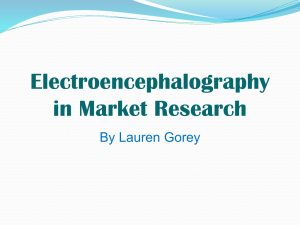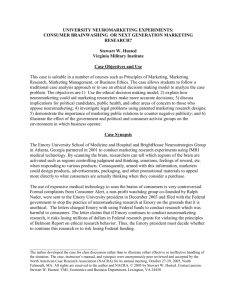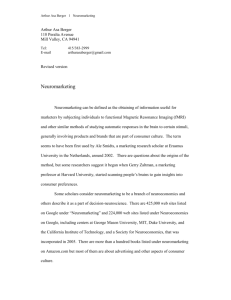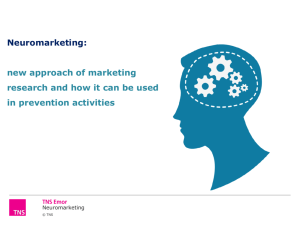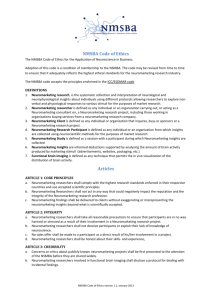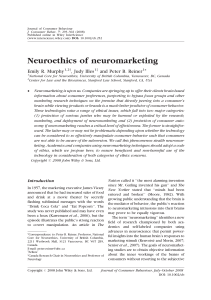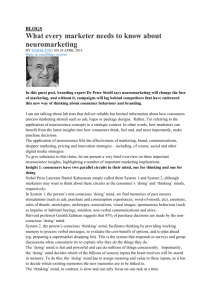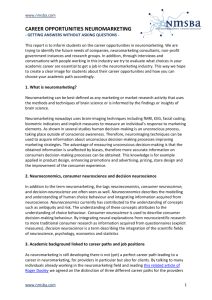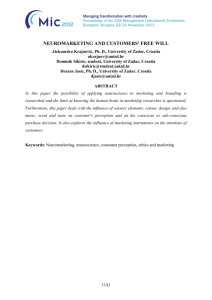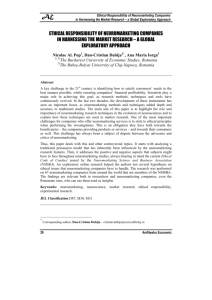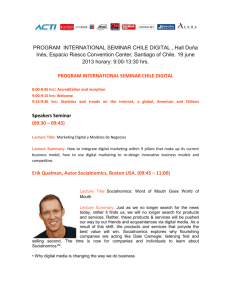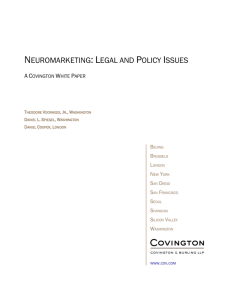NEUROMARKETING – SCIENCE AND PRACTICE
advertisement
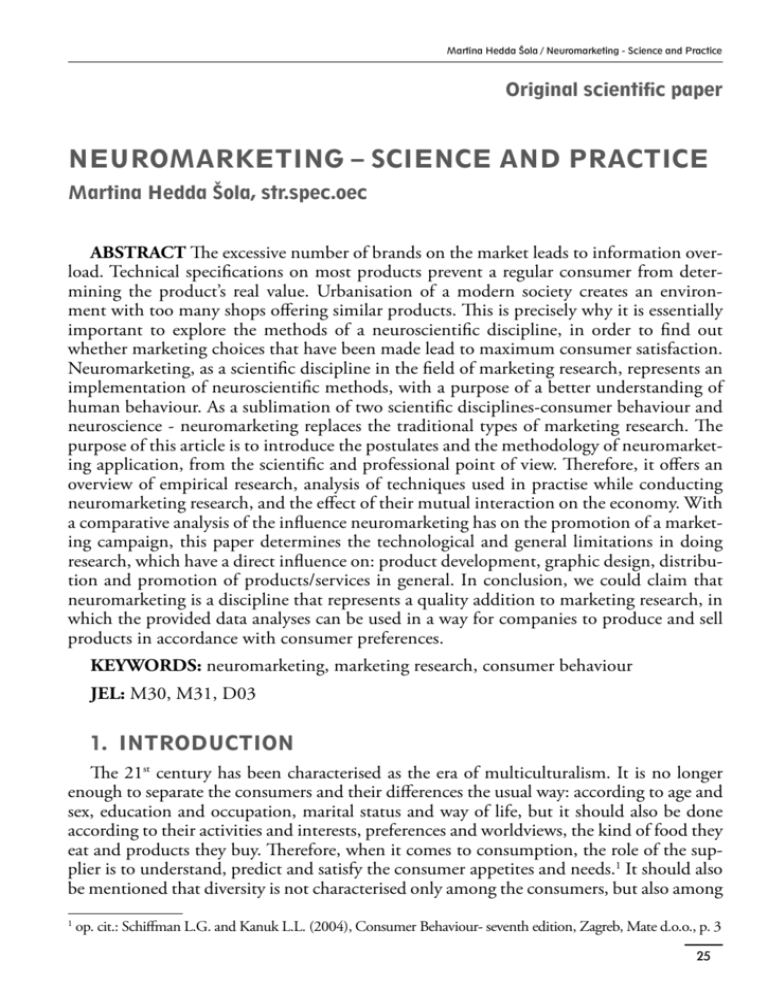
Martina Hedda Šola / Neuromarketing - Science and Practice Original scientific paper NEUROMARKETING – SCIENCE AND PRACTICE Martina Hedda Šola, str.spec.oec ABSTRACT The excessive number of brands on the market leads to information overload. Technical specifications on most products prevent a regular consumer from determining the product’s real value. Urbanisation of a modern society creates an environment with too many shops offering similar products. This is precisely why it is essentially important to explore the methods of a neuroscientific discipline, in order to find out whether marketing choices that have been made lead to maximum consumer satisfaction. Neuromarketing, as a scientific discipline in the field of marketing research, represents an implementation of neuroscientific methods, with a purpose of a better understanding of human behaviour. As a sublimation of two scientific disciplines-consumer behaviour and neuroscience - neuromarketing replaces the traditional types of marketing research. The purpose of this article is to introduce the postulates and the methodology of neuromarketing application, from the scientific and professional point of view. Therefore, it offers an overview of empirical research, analysis of techniques used in practise while conducting neuromarketing research, and the effect of their mutual interaction on the economy. With a comparative analysis of the influence neuromarketing has on the promotion of a marketing campaign, this paper determines the technological and general limitations in doing research, which have a direct influence on: product development, graphic design, distribution and promotion of products/services in general. In conclusion, we could claim that neuromarketing is a discipline that represents a quality addition to marketing research, in which the provided data analyses can be used in a way for companies to produce and sell products in accordance with consumer preferences. KEYWORDS: neuromarketing, marketing research, consumer behaviour JEL: M30, M31, D03 1. INTRODUCTION The 21st century has been characterised as the era of multiculturalism. It is no longer enough to separate the consumers and their differences the usual way: according to age and sex, education and occupation, marital status and way of life, but it should also be done according to their activities and interests, preferences and worldviews, the kind of food they eat and products they buy. Therefore, when it comes to consumption, the role of the supplier is to understand, predict and satisfy the consumer appetites and needs.1 It should also be mentioned that diversity is not characterised only among the consumers, but also among 1 op. cit.: Schiffman L.G. and Kanuk L.L. (2004), Consumer Behaviour- seventh edition, Zagreb, Mate d.o.o., p. 3 25 fip / Volume 1 / Number 1 / 2013 the suppliers and vendors. By introducing a separate marketing discipline, the economy has started to study the consumers in more detail, the ways individuals choose to invest their available resources (time, money, effort) into things connected to purchase (what is purchased, why it is purchased, where it is purchased, how often it is purchased and how often it is used). The key assumption, which is the basic marketing concept, lies on the premise that a supplier should create a product that can be sold, and not try and sell the product he has created.2 It is precisely why the desires and needs of consumers have always been the objects of marketing research. Although there is a huge disproportion between what the consumers think and what they say they think, the suppliers can develop a more effective marketing strategy, based on findings of why and how the consumers make their decisions of what to buy. This is why there was a sudden need for a new discipline- Neuromarketing, a combination of neuroscience, clinical psychology and economy. By studying the brain activity, neuromarketing combines the techniques of neuroscience and clinical psychology, in order to find out how we react to products, brands and commercials. The marketing experts are hoping that, based on these findings, they will try and understand the subtle layers that distinguish a successful campaign from an unsuccessful one.3 Besides this, neuromarketing could present a recent addition to marketing research. A company that wishes to increase the sales of its products, by using a quantitative method of testing the subconscious of a consumer and the direct influence of certain advertising campaigns, can make every marketing promotion measurable. Scientific research in neuroscience and marketing indicates that neuromarketing will cause a revolution, enabling us to see the differences below the surface. (Perrachione, T and Perrachione, 2008). However, the extent to which it is ethically justified to use this technique is hard to determine. This paper consists of five chapters. Following the Introduction, there is a detailed explanation of neuromarketing, from the scientific and professional point of view. The third chapter presents the empirical research and methods used in neuromarketing. The fourth chapter analyses the importance of applying neuromarketing in practice. The fifth chapter is the Conclusion. 2.NEUROMARKETING FROM THE SCIENTIFIC AND PROFESSIONAL POINT OF VIEW 2.1. Postulates of neuromarketing as a scientific discipline One of the most important senses we use when making a decision whether we can or cannot believe the people or situations in our line of sight. The optic nerve contains over a million fibers, compared to the auditory nerve, which contains only 30 000 fibres. The speed with which we receive and decode the information is visually measured in milliseconds (ms). Below 300 ms we cannot understand the process, or the most part of what we have seen in our higher cognitive functions. (Todorov, Engel and Haxby, 2006). This 2 3 Ibid, pp. 4-5 op. cit.: Mucha, T. (2005), This is your brain on advertising, Business 2.0,35, pp.7.-35 26 Martina Hedda Šola / Neuromarketing - Science and Practice is exactly where we can find the critical aspect of how we use the visual process functions while making any kind of decision of what to buy. A study conducted by Princeton University4 brought research of how we decode the faces we believe to, compared to faces that evoke our negative connotations. The study brought to realisation that, in this process, there is an organ called amygdala, located in the most primitive part of our brain, which based on something familiar or pleasant, brings a decision of who we see as positive or negative. The research has also shown that, after the photographs were shown to the experimental subjects, the amygdala was activated, quantitatively speaking, after 100 ms. A significant contribution brought by this study has proven that most decisions we make and hold on to are provoked precisely by our visual senses, without including the conscious centre of our brains. As an addition to this study, Princeton University has published a new study called „Predicting Political Elections from Rapid and Unreflective Face Judgments” (Ballew and Todorov, 2007). The subjects of the experiment had an assignment to choose between the two photographs of potential presidential candidates, for whom they thought could win the elections. Only those individuals who were not familiar with competencies of the two candidates were able to take part in research, and they had to reach their conclusions exclusively based on the visual aspect of photographs. 100 ms after the photograph had been shown to them, the individuals had their brains scanned by the Magnetic Resonance Imaging (MRI). The research has shown that the approximate probability of foreseeing the final result of elections, without including the conscious part of our brains, but using exclusively visual stimulus, is 80%. In other words, when the subjects of experiment had the unlimited possibility to think and look at the photographs without having their brains scanned, the deviations were not significant. 2.2. Genesis and Development of Neuromarketing After a long research on how the consumers make subconscious decisions of what to buy, marketing as a profession and a scientific discipline was able to see the fruits by introducing a new scientific discipline: Neuromarketing. The term neuromarketing was introduced by Ale Smidts in 2002. The founder and driving force of the discipline is Professor Martin Lindstrom (Oxford University). His three year research has cost Oxford University over 7 billion dollars, donated by eight multinational companies. Lindstrom used modern equipment used by contemporary medicine, and scanned over 2000 experimental brains, which were exposed to different marketing strategies including: positioning of a product, effect of sublimed messages, unoriginal brands and logos, health and security warnings, provocative design and packaging. Lindstrom unified the results in his new book5, where he has proved that 90% of consumers make final decisions on what to buy exclusively on a subconscious level. Explicitly 4 5 op.cit.: Williams, G. (1989), Comparative Media Study, Princeton University Press 22.50. cfr.: Lindstrom, M. (2009), Buyology: How Everything We Believe about Why We Buy is Wrong, London, Random House Business Books. 27 fip / Volume 1 / Number 1 / 2013 speaking, from the moment we enter a shop to the moment we make a final decision to buy, it takes less than four seconds, which means there is no rational explanation of our ability to think sensibly about shopping. All the decisions we make can be scientifically verified as results of the primitive subconscious part of our brain. As a result, we can conclude that neuromarketing begins where the traditional marketing research of consumer behaviour ends. Neuromarketing begins in the brain and perception of a consumer. 3.ELABORATE OVERVIEW OF EMPIRICAL RESEARCH AND METHOS USED 3.1. Generally Accepted Methods Methods generally accepted in generating neurological visualisation can be divided into three categories: Electroencephalography (EEG), Magnetoencephalography (MEG), and Functional Magnetic Resonance Imaging (fMRI), which is the newest and the most popular method.6 1. BIOLOGICAL METHODS • fMRI – visualises the specific neural activities in the brain during the decision making • EEG – by recording the brain data is received on the specific electric activity in the short period while making the decision to buy • MEG – measures the magnetic fields that produce the brain’s electric activity while deciding on what to buy 2. ECONOMIC METHODS • Game Theory – simulated situations for detecting the individual’s behaviour, where success depends exclusively on the choice of another individual 3. PSYCHOLOGICAL METHODS • Different behavioural studies and analyses These neuroscientific methods analyse the human behaviour with the aim of finding out what happens on a structural and functional level of a human brain. There are three wide components used for conducting neuromarketing research of consumer behaviour: a) LOCALISATION – studying a part of the brain essential for provoking reactions, b) CONNECTION – studying interactions of different parts of the brain which use the same pattern in processing information, c) REPRODUCTION – studying information, which are stored in the brain and represent the “codes” that trigger these information. It is important to underline here that understanding of these “codes” is of significant importance for several neuroscientific achievements, especially for “interpretation” of cur6 c fr.: Fugate, D. (2007), Neuromarketing: a layman’s look at neuroscience and its potential application to marketing practice, Jorunal of Consumer Marketing, Vol 24, issue 7, pp. 385-394. 28 Martina Hedda Šola / Neuromarketing - Science and Practice rent thoughts and experiences of individuals, in order to be able to assess their mental state at the moment of stimulation of an experimental subject (by commercials and products) in real time.7 The neuroscientists have demonstrated that there are three parts of our brain that mutually interact, and each one of them has a specific function. • “The New Brain“ thinks. From the moment it receives information, it processes only rational data, and it shares the filtered data with the other two brain parts. • “The midbrain“ feels. It processes emotion and it shares only the positive ones with the other two parts. • “The Old Brain” makes decisions. It receives suggestions from both brains (new and mid-brain), but it solely controls the decision making process. Now that is familiar that the “old brain” is the one making final decisions, the marketing and commercial strategy can adopt completely different communication principles, in order to be make an impression.8 Marketing analysts will be using neuromarketing in order to measure the consumer preferences more precisely than simple verbal answer to a question: Do you like this product? In most cases, an answer to this question does not produce honest answers, as a result of cognitive bias. This information can be helpful to marketing experts in creating their own products and services, in order to make them more effective, as well as focus their promotional campaigns on brain answers. Neuromarketing can offer answers to questions on how the consumers react to a product, to its colour, design or package, sound or an idea, or what the consumers would want and you do not have it. 3.2. Scientific Research in Neuromarketing Practise has shown the direct connect connection between a brand of a certain product and the brain. The results of scientific research were so striking that even scientists and advertisers started to pay attention to facts they discovered in research. In fact, understanding how the human brain functions at the moments of making the decision to buy have proven to be indispensable. 1. “THE PEPSI PARADOX” In 2004 the Centre of Theoretical Neuroscience at the Baylor College of Medicine has published a study called “Read Montague”, which is one of the earliest published marketing studies. The scientists have found inspiration for the study from the latest Pepsi campaign (Pepsi Challenge). During research they have tested 67 individuals (experimental subjects), whose brains were scanned after being given Pepsi and Coca Cola. The results of a blind study (upon asking the experimental subjects which beverage they would rather choose), have shown that half of the subjects would opt for Coca Cola, and the other half for Pepsi. o p. cit.: Perrachione, T. and Perrachione, J. (2008), Brains and Brands: Developing mutually informative research in neuroscience and marketing, Jorunal of Consumer Behaviour, Vol 8, issue 5, pp. 303-318. 8 op. cit.: Wannamaker J (1876), Publicité Montréal Publicité Cognitive. 7 29 fip / Volume 1 / Number 1 / 2013 However, when the individuals were asked to drink Coca Cola for half an hour, and then Pepsi, 75% concluded that Coca Cola had a better taste, while 25% chose Pepsi. However, cumulative results were significantly different. Research results have shown that consumers choose Coca Cola exclusively for the brand, regardless of its taste, while they opt for Pepsi exclusively for the taste. This study has finally shown why Pepsi has not won the so called “Coca Cola war”, because even though consumers thought Pepsi tasted better, their emotional attachment to Coca Cola brand was stronger.9 2. BUYLOGY In one of his studies, M. Linstrom has done research on the connection between the warning messages on cigarette packs (“smoking causes lung cancer”) and the effect it had on smokers. Research has proven that these warnings have absolutely no effect on smokers. The reason for this lies in the fact that these messages stimulate one part of the smokers’ brain (nucleus accumbens) and encourage them to light a cigarette.10 3. „AMERICAN IDOL“ M. Lindstrom has dome research connected to placement of products in the TV commercials, with a primary goal- to discover whether the viewers remembered a specific logo. During the TV show “American Idol” (2008) three products were the subject of research: Coca Cola, Cingular Wireless and Ford. They all paid equal amounts for publishing on a TV show, but Coca Cola was present 60% of the time, Cingular Wireless had a smaller share (the host kept repeating to viewers that they can vote by telephone, if they are using C.W., with constant presence of the company logo in the back), while Ford only had a 30 second share during commercial breaks. Results of a blind research before the show have shown that experimental subjects have not memorised any of the products more than the others which were advertised before the beginning of the show. After the end of the show, Coca Cola was most remembered. Research has shown that the abundance of Coca Cola commercial has caused the suppression of memory of the Ford messages. Practice has shown that consumers do not remember brands that are not an integral part of the shows they watch.11 4. SUBLIMED MESSAGES The purpose of the research was to determine whether the sublimed messages (subconscious images) affect the cigarette consumption. The experimental subjects were first shown the photos which had no connection with the cigarette brand (the landscapes of the American Wild West and sunset in the desert). This was followed by fMRI scans, which recorded the activity in the part of the brain responsible for rewarding, lust and o p.cit.: Alčaković S. (2011), Neuromarketing- A New Method of Understanding Consumers, Synergy University, Beograd, p. 277 10 cfr.: Lindstrom, M. (2009), Buyology: How Everything We Believe about Why We Buy is Wrong, London, Random House Business Books. 11 cfr.: Lindstrom, M. (2009), Buyology: How Everything We Believe about Why We Buy is Wrong, London, Random House Business Books. 9 30 Martina Hedda Šola / Neuromarketing - Science and Practice envy. In other words, research has shown that there is more brain activity in the centre for rewarding and lust when the experimental subject is exposed to sublimed images of a well known brand. The sunset has increased cigarette consumption.12 4.IMPORTANCE OF PRACTICAL APPLICATION OF NEUROMARKETING 4.1. Influence of Neuromarketing on a Promotional Campaign Practice has shown that neuromarketing techniques have a direct influence on promotion. If it is a billboard campaign, neuromarketing techniques depend on location and duration of a campaign. Each type of marketing promotion is influenced differently by the neuromarketing methods and techniques, which can be seen in more detail below: PROMOTION TYPE INFLUENCE OF NEUROMARKETING: TV/Radio Commercial • Choice of radio station • Duration Online advertising • Content of the advertisement • Duration of promotion Point of purchase advertising • Choice of location • Choice of product Sponsoring • Choice of celebrity • Famous events Source: Reynolds, J. (2006), Measurement and Analysis for Marketing, Journal of Targeting, Vol. 14 No.3, pp.189-90. 4.2. Influence of Neuromarketing on the Graphic Design PROMOTION TYPE INFLUENCE OF NEUROMARKETING: Billboard campaign • Poster size • Colour distribution • Marketing message • Choice of a celebrity TV commercial • Duration • Choice of product-focus • Balance of information-entertainment • Colour distribution • Images • Speaker/music Source: Reynolds, J. (2006), Measurement and Analysis for Marketing, Journal of Targeting, Vol. 14 No.3, pp.189-90. 12 Ibid. 31 fip / Volume 1 / Number 1 / 2013 4.3. Influence of Neuromarketing on the Product Development PRODUCT DEVELOPMENT INFLUENCE OF NEUROMARKETING: Introduction of a new product on the market • Taste, scent and colour of a product • Health/fashion trends • Identification of new target groups Product design/packaging • Location of logo • Colour distribution • Packaging material • Packaging size • Series limitation • Scent Product distribution • Position on the shelf • Positioning of a product • Conceptualization of special offers • Scent, music and general impression of object • Product availability Source: Reynolds, J. (2006), Measurement and Analysis for Marketing, Journal of Targeting, Vol. 14 No.3, pp.189-90. 4.4. Limitations of Neuromarketing Research TYPE OF LIMITATION: SPECIFICATION: Technological limitations • 7% of subjects tested around the world are not suitable for brain testing • Outdated and loud machines can result in subjects giving up on taking part in research • Subjects can offer wrong answers because of fear • Big and inflexible machines • Testing demands medical supervision • Due to time and financial limitations, limited number of subjects can take part in research General limitations • Consumer behaviour cannot be studied retroactively in a laboratory • Brain activities cannot be measured without prior consent of a consumer • Ethical questions should not be reduced exclusively to the field of neuromarketing • Limited accuracy of measuring the brain activity Source: Mucha, T.(2005), This is your brain on advertising, Business 2.0,35 pp.7-35., Mucha, T. (2005), Why the caveman loves the pitchman, Business 2.0.,35, pp.9-37. As it is evident from the sample, there are certain technological and general limitations to neuromarketing. It is precisely because of these types of limitations that we can con32 Martina Hedda Šola / Neuromarketing - Science and Practice clude neuromarketing is a discipline which cannot be considered separately, but as a part of the discipline of marketing, where it can serve as an addition to marketing research. 5.CONCLUSION AND PROPOSALS FOR FUTURE RESEARCH This paper had two disputable goals: introduce the postulates and methodology of neuromarketing application from a scientific and professional point of view. Market complexity results in consumers buying overpriced products. Also, the decisions that we make are not rational, as long as understanding of product quality is based on unreliable information. Greater customer satisfaction cannot be achieved through investing in the quality of a product, as the market is overloaded with information. The price is used as an indicator of product quality, which results in higher expectations for a product and determines higher degree of satisfaction while purchasing. Precisely all of the above has produced different views all over the world. In order to please the consumer, different academics advocate and encourage the development of neuromarketing as a scientific discipline, as clinical and non-clinical research methods will contribute to higher quality and better understanding of consumers. Those who are advocating for neuromarketing (Advertising Age, Feit) explain it as something that will revolutionise the marketing discipline, by enabling the consumers to notice the underlying differences.13 However, the critics (Commercial Alert, Gary Ruskin, Ralph Nadar and Lior Arussy) have characterised neuromarketing as a new chapter of old tricks for deceiving consumers, where ruthless marketing experts are able to make the consumers buy any product, by exploiting the biological structure of the brain.14 Neuromarketing is a discipline which should be an addition to marketing research, and as such, it should yield the most realistic results and should not break the ethical rules, as the results of the analyses would be used in order to produce and sell products based on consumer preferences. Neuromarketing imposes itself as an indispensable tool for modern marketing experts, where based on research results of Fortune 500, five hundred biggest American companies, such as McDonalds, large banks, film studios and political campaigns, order neuromarketing studies. Although this paper is based on the fundamentals of neuromarketing from a scientific and professional point of view, nevertheless, a question imposes itself whether neuromarketing techniques represent a truly safe tool that will generate products in accordance with consumer preferences. Furthermore, with all its endless potential, there is still a need to introduce the control mechanisms of consumer protection, so that the techniques of neuromarketing are not used for unethical purposes, which presents a topic for further research and discussions. o p.cit.: Fugate D. (2009), Marketing services more effectively with neuromarketing research: a look into the future, Journal of Services Marketing, Vol.22, Issue 2, pp.170-173. 14 op.cit.: Perrachione, T., Perrachione, J (2008), Brains and brands, Journal of Consumer Behaviour, Vol.8, Issue 5, pp.303-318 13 33 fip / Volume 1 / Number 1 / 2013 BIBLIOGRAPHY Books: Lindstrom, M. (2009). Buyology: How Everything We Believe about Why We Buy is Wrong. Random House Business Books. London. Schiffman, L.G. i Kanuk,L.L. (2004). Ponašanje potrošača-sedmo izdanje. Mate d.o.o. Zagreb. Journals: Fugate, D. (2009). Marketing services more effectively with neuromarketing research: a look into the future. Journal of Services Marketing Vol.22 Issue 2. London. Fugate, D. (2007). Neuromarketing: a layman’s look at neuroscience and its potential application to marketing practice. Jorunal of Consumer Marketing Vol. 24 issue 7. London. Mucha, T. (2005). This is your brain on advertising. Business 2.0, 35 (August). NJ. Mucha, T. (2005). Why the caveman loves the pitchman. Business 2.0, 6(3). NJ. Perrachione, T. Perrachione, J. (2008). Brains and Brands: Developing mutually informative research in neuroscience and marketing. Jorunal of Consumer Behaviour, Vol. 8 issue 5. London. Reynolds, J. (2006). Measurement and Analysis for Marketing. Journal of Targeting Vol. 14 No.3. London. Williams G. (1989). Comparative Media Study. Princeton University Press 22.50. NJ. Wannamaker, J. (1876). Publicité Montréal Publicité Cognitive. Montreal. Conference Papers: Alčaković, S. (2011). Neuromarketing-nov način razumevanja potrošača. 8. Naučni skup sa međunarodnim učešćem Sinergija 2011, p. 277. Beograd. 34
